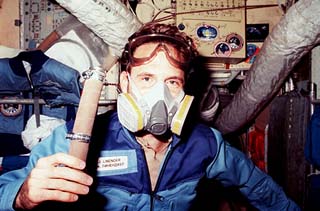


This NASA news release followed the fire onboard Mir:
February 24, 1997, Johnson Space Center, Houston, TX
SMALL FIRE EXTINGUISHED ON MIR
A problem with an oxygen-generating device on the Mir space station last night set off fire alarms and caused minor damage to some hardware on the station. No injuries to any of the six crewmembers onboard were reported. The fire was located in the Kvant-1 module.
The fire, which began at 10:35 p.m. Sunday, Moscow time, burned for about 90 seconds. The crew was exposed to heavy smoke for five to seven minutes and donned masks in response. After completing physical exams of everyone onboard, U.S. astronaut Jerry Linenger, a physician, reported that all crewmembers are in good health. Medical personnel have directed them to wear goggles and masks until an analysis of the Mir atmosphere has been completed.
Lithium perchlorate candles are burned to generate supplemental oxygen when more than three people are onboard the space station. The oxygen-generating candles usually burn for five to 20 minutes. Russian officials believe the problem began when a crack in the oxygen generator's shell allowed the contents of the cartridge to leak into the hardware in which it was located. Crewmembers extinguished the fire with foam from three fire extinguishers, each containing two liters of a water-based liquid.
The damage to some of Mir's hardware resulted from excessive heat rather than from open flame. The heat destroyed the hardware in which the device, known as a "candle," was burning, as well as the panel covering the device. The crew also reported that the outer insulation layers on various cables were melted by the heat. It is reported by Russian flight controllers that all Mir systems continue to operate normally, however.
"It is unfortunate that this incident occurred, but we are thankful that there were no injuries," said Frank Culbertson, Director of the Phase 1 Shuttle-Mir program. "Russian management and operations specialists have been very informative as to what happened, and we are working closely with them on evaluating the health of the crew and how best to respond to the damage," added Culbertson.
"The crew did a great job handling the fire, and the ground support has been excellent on both sides."
In addition to Linenger, the Mir crewmembers include Mir-22 cosmonauts Valeri Korzun and Alexander Kaleri, Mir-23 cosmonauts Vasily Tsibliev and Aleksandr Lazutkin, and German researcher Reinhold Ewald, representing the German space agency, DARA. Korzun, Kaleri and Ewald are scheduled to return to Earth on Sunday as previously planned to wrap up a six-month mission for Korzun and Kaleri and three weeks of scientific experiments for Ewald. Linenger will remain aboard Mir until mid-May with Tsibliev and Lazutkin.
Officials are evaluating possible impacts to the mission and its science activities, as technical experts at the Russian Mission Control Center investigate the incident. The burned panel and other materials may be returned to Earth with Korzun, Kaleri and Ewald on Sunday for further analysis.
Related Links:
Culbertson
on the Fire
Linenger Increment
Risk and Safety
Video: Mir-22/23 (Linenger/fire)
Video: Linenger
Fire Description
Foale on Fire and "Near Miss"
![]()
|
|
Curator:
Kim Dismukes
Responsible NASA Official: John Ira Petty |
.gif)